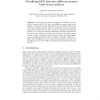Free Online Productivity Tools
i2Speak
i2Symbol
i2OCR
iTex2Img
iWeb2Print
iWeb2Shot
i2Type
iPdf2Split
iPdf2Merge
i2Bopomofo
i2Arabic
i2Style
i2Image
i2PDF
iLatex2Rtf
Sci2ools
ICANN
2007
Springer
2007
Springer
Classifying EEG Data into Different Memory Loads Across Subjects
Abstract. In this paper we consider the question of whether it is possible to classify n-back EEG data into different memory loads across subjects. To capture relevant information from the EEG signal we use three types of features: power spectrum, conditional entropy, and conditional mutual information. In order to reduce irrelevant and misleading features we use a feature selection method that maximizes mutual information between features and classes and minimizes redundancy among features. Using a selected group of features we show that all classifiers can successfully generalize to the new subject for bands 1-40Hz and 160Hz. The classification rates are statistically significant and the best classification rates, close to 90%, are obtained using conditional entropy features.
Conditional Entropy | Conditional Entropy Features | Conditional Mutual Information | ICANN 2007 | Neural Networks |
| Added | 16 Aug 2010 |
| Updated | 16 Aug 2010 |
| Type | Conference |
| Year | 2007 |
| Where | ICANN |
| Authors | Liang Wu, Predrag Neskovic |
Comments (0)

